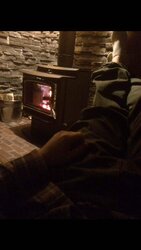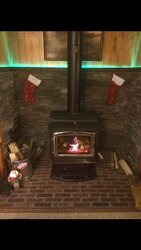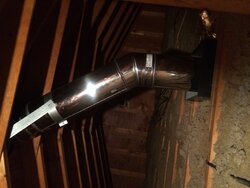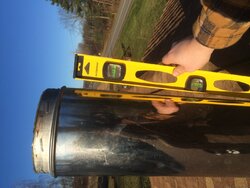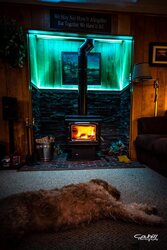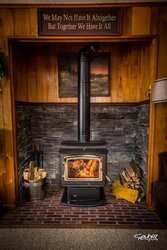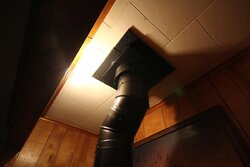Hey guys, new to the forum- read quite a few posts already. Also new to wood burning. My first stove is a Enviro Kodiak 1200. She heats up the living room to 83 some days. Still trying to get down a good consistent fire on a daily basis. Have burned a few times with coals in the morning after loading her up good the night before. I'm posting to see what others have to say about the Enviro's & any help of controlling it better. I have had a few instances where shes gotten up to 725-750 (stove top & IR) Some wood I am burning is a bit wet 28-30% moisture, been trying to find driest pieces I can (got wood late). Don't know if I'm causing too much smoke which is burning and getting the stove up too hot (if thats possible from wetter wood- I know wet would cause more steam as well) or possibly the door isnt sealing properly. I dunno, figured I would throw this out there to you guys and see what you have to add. I attached a picture of my set up. Stove was professionally installed, but I did the stone, brick, woodwork, and led lights. Let me know what you think.
Enviro Kodiak 1200
- Thread starter teamblue0171
- Start date
-
Active since 1995, Hearth.com is THE place on the internet for free information and advice about wood stoves, pellet stoves and other energy saving equipment.
We strive to provide opinions, articles, discussions and history related to Hearth Products and in a more general sense, energy issues.
We promote the EFFICIENT, RESPONSIBLE, CLEAN and SAFE use of all fuels, whether renewable or fossil.
You are using an out of date browser. It may not display this or other websites correctly.
You should upgrade or use an alternative browser.
You should upgrade or use an alternative browser.
- Status
- Not open for further replies.
Welcome, nice stove.
Try closing the air sooner, around 300F. On a reload be sure to burn down the coal bed enough to avoid a large flare up. Take it down to about an inch or so. If possible increase the size of the splits.
The door can be checked when cold with a dollar bill test. Close the door on the bill and then pull it out. There should be some resistance as it is pulled out. Check around the door in several places.
Try closing the air sooner, around 300F. On a reload be sure to burn down the coal bed enough to avoid a large flare up. Take it down to about an inch or so. If possible increase the size of the splits.
The door can be checked when cold with a dollar bill test. Close the door on the bill and then pull it out. There should be some resistance as it is pulled out. Check around the door in several places.
lml999
Minister of Fire
I have the same stove in an insert version. I get consistent 700 degree stove top temps after I get a fire going. It hangs there for a while and then gradually drops off. My wood is relatively dry but my splits are small. I am waiting for some larger oak, maple and pine splits to season.
I think your primary issue is your wet wood. You will not get a good consistent fire with that wood. I got one load a couple of years ago that would just not put out any heat...didn't have a meter at the time, so I couldn't check it. Dry wood makes a *huge* difference.
If you have the space, bring a bundle of wood into the house and let it sit for a week, preferably near the stove. Or borrow a good size bundle from a neighbor with seasoned wood.
Once you have a good wood supply, play around with the stove. Build a fire, let it get established and gradually shut down the air supply. I run my stove with the supply completely closed for a couple of hours, then crack it open an inch or so. I think I am also due for a new gasket... Curious to see how that affects burn times.
I think your primary issue is your wet wood. You will not get a good consistent fire with that wood. I got one load a couple of years ago that would just not put out any heat...didn't have a meter at the time, so I couldn't check it. Dry wood makes a *huge* difference.
If you have the space, bring a bundle of wood into the house and let it sit for a week, preferably near the stove. Or borrow a good size bundle from a neighbor with seasoned wood.
Once you have a good wood supply, play around with the stove. Build a fire, let it get established and gradually shut down the air supply. I run my stove with the supply completely closed for a couple of hours, then crack it open an inch or so. I think I am also due for a new gasket... Curious to see how that affects burn times.
I have the same stove in an insert version. I get consistent 700 degree stove top temps after I get a fire going. It hangs there for a while and then gradually drops off. My wood is relatively dry but my splits are small. I am waiting for some larger oak, maple and pine splits to season.
I think your primary issue is your wet wood. You will not get a good consistent fire with that wood. I got one load a couple of years ago that would just not put out any heat...didn't have a meter at the time, so I couldn't check it. Dry wood makes a *huge* difference.
If you have the space, bring a bundle of wood into the house and let it sit for a week, preferably near the stove. Or borrow a good size bundle from a neighbor with seasoned wood.
Once you have a good wood supply, play around with the stove. Build a fire, let it get established and gradually shut down the air supply. I run my stove with the supply completely closed for a couple of hours, then crack it open an inch or so. I think I am also due for a new gasket... Curious to see how that affects burn times.
Have you guys ever read this article. The Florida Bungalow Syndrom. http://www.gulland.ca/florida_bungalow_syndrome.htm
there are some definite similarities to what i am experiencing.
Can you describe the flue system? How tall is the total run and how it is configured? Straight up and out or through the wall?
Howdy. I've got Enviro 1700 Kodiak insert. It's my 3rd season with it. Enviro product IMO are solid products. You have a good stove. Some things I've learned in that time:
Dry and well seasoned wood makes a huge impact. Can't overstate this enough.
Be patient with the air adjustment. A small movement makes a big difference. Especially when considering the dry wood comment above.
Outside temperature differential makes an impact on draft strength. Ie less differential equals less draft. Add less than seasoned wood to this and it's tough to control.
Last point, each stove and setup is unique. Flue length, wood species, MC%, climate, and operator experience.
It will only get better and more dialed. Rest assured you have a good quality stove you just need to work the variables of your "experiment" to achieve optimum burning.
Love this stuff! Wood burning is an awesome lifestyle and before you know it you're hooked. Happy burning.
Dry and well seasoned wood makes a huge impact. Can't overstate this enough.
Be patient with the air adjustment. A small movement makes a big difference. Especially when considering the dry wood comment above.
Outside temperature differential makes an impact on draft strength. Ie less differential equals less draft. Add less than seasoned wood to this and it's tough to control.
Last point, each stove and setup is unique. Flue length, wood species, MC%, climate, and operator experience.
It will only get better and more dialed. Rest assured you have a good quality stove you just need to work the variables of your "experiment" to achieve optimum burning.
Love this stuff! Wood burning is an awesome lifestyle and before you know it you're hooked. Happy burning.
Can you describe the flue system? How tall is the total run and how it is configured? Straight up and out or through the wall?
Not sure of the exact height (Room has 8' ceiling with 4' @ ridge attic above it). Flue goings straight up, then jogs with (2)45 degrees around rafter then in attic they jogged with (2) 30 degrees (I think, mumbled something about not being able to use 45's in the attic?) to miss ridge of roof. To me the thing looks like its crooked on the roof, but after shop came back to fix, it looked like its leaning more. I finally went on roof with level, see attached pictures.
Attachments
It doesn't sound like you have too much pipe. How much is above the roof?
Crooked pipe would drive me nuts. It also looks like they might have used a cathedral ceiling support box and no proper attic insulation shield. How many installs have these guys done?
Crooked pipe would drive me nuts. It also looks like they might have used a cathedral ceiling support box and no proper attic insulation shield. How many installs have these guys done?
My thoughts exactly. They claimed to me that they were "the best". I highly doubt that statement anymore. I feel I could have done a better install job myself, but none the less. The ceiling box may have been because of the rafters being doubled up in that exact spot, maybe thats all that could fit? it was a 12 1/2" spacing. about 2-3' above roofIt doesn't sound like you have too much pipe. How much is above the roof?
Crooked pipe would drive me nuts. It also looks like they might have used a cathedral ceiling support box and no proper attic insulation shield. How many installs have these guys done?
Attachments
Crooked pipe would make me nutty too.
That box in the attic with no fireproof / non combustible insulation around it looks sketchy. What if some loose insulation somehow got into that box? Or rodents started filling it up to make a warm home. That box at a minimum should be sealed up.
By the way, nice aesthetic hearth and stove setup.
That box in the attic with no fireproof / non combustible insulation around it looks sketchy. What if some loose insulation somehow got into that box? Or rodents started filling it up to make a warm home. That box at a minimum should be sealed up.
By the way, nice aesthetic hearth and stove setup.
- Status
- Not open for further replies.
Similar threads
- Replies
- 6
- Views
- 1K
- Replies
- 3
- Views
- 637
- Replies
- 2
- Views
- 1K


